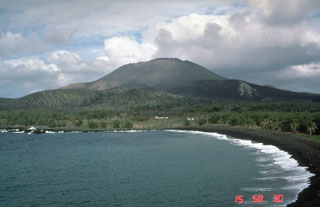Report on Pagan (United States) — November 1982
Scientific Event Alert Network Bulletin, vol. 7, no. 11 (November 1982)
Managing Editor: Lindsay McClelland.
Pagan (United States) Tephra ejection
Please cite this report as:
Global Volcanism Program, 1982. Report on Pagan (United States) (McClelland, L., ed.). Scientific Event Alert Network Bulletin, 7:11. Smithsonian Institution. https://doi.org/10.5479/si.GVP.SEAN198211-284170
Pagan
United States
18.13°N, 145.8°E; summit elev. 570 m
All times are local (unless otherwise noted)
Personnel on a USN training flight observed activity at Pagan when they flew near the volcano about 1415 on 10 December. A hole roughly 60 m below the crater rim on the NW side was spewing debris and brown smoke. Light-colored vapor was emerging from the center of the crater. Burning was seen along the S and SW slopes, but a cause could not be determined [see 8:3].
Geological Summary. Pagan Island, the largest and one of the most active of the Mariana Islands volcanoes, consists of two stratovolcanoes connected by a narrow isthmus. Both North and South Pagan stratovolcanoes were constructed within calderas, 7 and 4 km in diameter, respectively. North Pagan at the NE end of the island rises above the flat floor of the northern caldera, which may have formed less than 1,000 years ago. South Pagan is a stratovolcano with an elongated summit containing four distinct craters. Almost all of the recorded eruptions, which date back to the 17th century, have originated from North Pagan. The largest eruption during historical time took place in 1981 and prompted the evacuation of the sparsely populated island.
Information Contacts: Cmdr. J. Walker and Lt. J. Meyer, COMNAVMAR.

